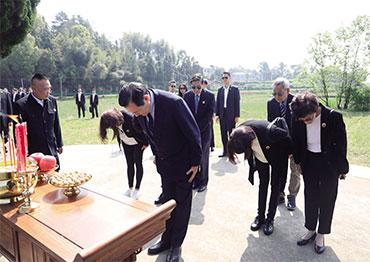Against this backdrop of swinging public sentiment, Taiwan’s former leader Ma Ying-jeou embarked on a 12-day trip to the Chinese mainland between March 27 to April 7, which almost entirely coincided with Tsai’s trip to the US and Central America from March 29 to April 7.
Serving as Taiwan’s leader from 2008 and 2016, Ma remains a senior member of the KMT. Born in 1950 in Hong Kong to mainland parents from Hunan Province, Ma’s family moved to Taiwan in 1952.
During his tenure as Taiwan leader, the two sides of the Taiwan Straits agreed to recognize the 1992 Consensus. The 1992 Consensus refers to the consensus reached in 1992 by the mainland-based Association for Relations Across the Taiwan Straits and the Taiwan-based Straits Exchange Foundation. They agreed to state that “the two sides of the Taiwan Strait both stick to the one-China principle.” The agreement helped stabilize cross-Straits relations and paved the way for closer economic ties between the two sides.
In 2015, Xi Jinping and Ma held a historic meeting in Singapore, marking the first meeting between leaders from the two sides of the Taiwan Straits. But Ma was soon replaced by Tsai in 2016, who abandoned the 1992 Consensus, and relations have nose-dived ever since.
As tensions continued to escalate, Ma repeatedly called to revive the 1992 Consensus, which is the political foundation of the cross-Straits relationship.
Leading a youth delegation from Taiwan, Ma visited his ancestral home in Hunan Province. He also went to the cities of Wuhan, Changsha, Chongqing and Shanghai, and visited sites connected to the history of World War II, during which the KMT joined hands with the Communist Party of China in fighting against the Japanese invasion. In Nanjing, China’s capital during the KMT’s rule until 1949, Ma visited the Memorial Hall of the Victims in Nanjing Massacre by Japanese Invaders.
Ma also paid a visit to the Sun Yat-sen Mausoleum in Nanjing. As the founding father of China’s republican revolution that overthrew the Qing Dynasty in 1912 and a co-founder of the KMT, Sun (1866-1925) is revered in both Taiwan and the mainland.
“People on both sides of the Taiwan Straits are Chinese people, and are both descendants of the Yan and Yellow emperors,” Ma said in his speech at the Sun Yat-sen Mausoleum, referring to the semi-mythical rulers that are accredited for the first integration of the Chinese people.
“We sincerely hope the two sides will work together to pursue peace, avoid war and strive to revitalize China... This is an unavoidable responsibility of Chinese people on both sides of the Straits, and we must work hard,” Ma added.
On March 30, Song Tao, head of the Taiwan Work Office of the Communist Party of China Central Committee and the Taiwan Affairs Office of the State Council, met with Ma in Wuhan, Central China’s Hubei Province. Song conveyed the greetings from Xi Jinping, general secretary of the CPC Central Committee, to Ma, and both Song and Ma reiterated their commitment to adhering to the 1992 Consensus. Ma was also warmly received by high-level provincial CPC officials in Jiangsu, Hunan, Hubei and Chongqing. A group of Taiwan students led by Ma held talks with the mainland students in Fudan University, Hunan University and Wuhan University.
Flying back to Taiwan on April 7, Ma told a group of supporters at Taipei’s Taoyuan Airport that Taiwan’s current leaders have led the Taiwanese people into a dangerous situation. “For Taiwan’s future, the choice is now peace or war,” Ma said.
He called to reinstate the 1992 Consensus. “I have shown with my own actions that by adhering to the 1992 Consensus, respecting each other and seeking common ground while preserving our differences, we can restore the political foundation and resume communication and dialogues with the mainland, which is in the best interests of Taiwanese people,” Ma said.
Arriving back at Taoyuan Airport the same day, Tsai gave her own vision for Taiwan’s future. “Taiwan will not be stopped from engaging with the world and will not give in to external pressure,” said Tsai. Thanking US Congress members for their support, Tsai said Taiwan is not alone.
With the two sides of Taiwan politics now gear up for the next leadership election in 2024, Taiwan’s soul-searching for its position in the escalating antagonism between the US and China set to continue.

 Old Version
Old Version


